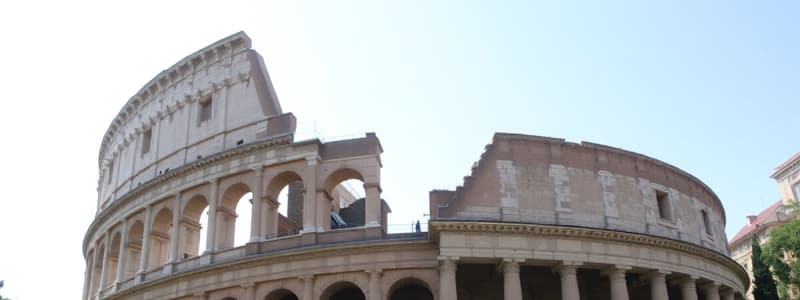Podcast
Questions and Answers
What construction method did the Romans extensively use to build larger structures?
What construction method did the Romans extensively use to build larger structures?
- Concrete (correct)
- Brick
- Wood
- Steel
The Romans invented the arch, the vault, and the dome.
The Romans invented the arch, the vault, and the dome.
False (B)
What is a dome?
What is a dome?
A vault in the shape of a half-circle that rests on a circular wall.
The famous stadium in Rome is known as the ___.
The famous stadium in Rome is known as the ___.
Match the following Roman innovations with their descriptions:
Match the following Roman innovations with their descriptions:
Which of the following characteristics made Roman roads unique?
Which of the following characteristics made Roman roads unique?
The Pantheon is known for its square-shaped roof.
The Pantheon is known for its square-shaped roof.
What did early medieval architects frequently imitate from Roman designs?
What did early medieval architects frequently imitate from Roman designs?
The Arc de Triomphe in Paris commemorates the victories of ___ during the early 1800s.
The Arc de Triomphe in Paris commemorates the victories of ___ during the early 1800s.
Which type of construction was innovative for the Colosseum?
Which type of construction was innovative for the Colosseum?
Flashcards are hidden until you start studying
Study Notes
Roman Architecture
- Romans mastered the arch, vault, and dome for building massive structures.
- Vaults are arched ceilings or supports, while domes are half-circle vaults resting on circular walls.
- Roman baths and buildings often featured arched vaults, like the Pantheon's renowned dome.
- Romans innovated concrete use for constructing larger arches than previously possible.
- They weren't the inventors of concrete, but pioneers of its extensive use.
- Romans invented stadiums, large open-air structures accommodating thousands.
- Colosseum's tunnels built with concrete facilitated spectator access, a feature still used in modern stadiums.
- Roman architectural style inspired many architects throughout history, including medieval churches and cathedrals.
- Modern churches, banks, and government buildings, like the U.S. Capitol, display Roman influence.
- The triumphal arch, a monument celebrating victories or achievements, is another Roman innovation widely copied.
- The Arc de Triomphe in Paris, commemorating Napoleon's victories, is a renowned example, now serving as France's national war memorial.
Roman Engineering
- Romans excelled in road, bridge, and aqueduct construction, surpassing predecessors.
- Over 50,000 miles of Roman roads connected Rome to the empire's frontiers.
- Roman roads were built with layers of stone, sand, and gravel, setting a 2,000-year standard.
- Europeans still use highways built over old Roman roads.
- Romans revolutionized aqueduct construction, bringing water from distant sources to Rome's elite homes, baths, and fountains.
- Aqueduct systems built in other parts of the empire, like Segovia, Spain, still utilize ancient Roman structures.
- Roman aqueduct arches remain in Europe, North Africa, and Southwest Asia.
Studying That Suits You
Use AI to generate personalized quizzes and flashcards to suit your learning preferences.




